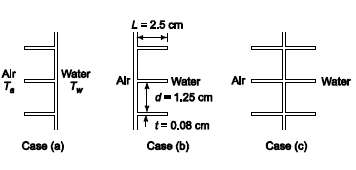Heat is transferred from water to air through a brass wall (k = 54 W/(m K)). The
Question:
Heat is transferred from water to air through a brass wall (k = 54 W/(m K)). The addition of rectangular brass fins, 0.08 cm thick and 2.5 cm long, spaced 1.25 cm apart, is contemplated. Assuming a water-side heat transfer coefficient of 170 W/(m2 K) and an air-side heat transfer coefficient of 17 W/(m2 K), compare the gain in heat transfer rate achieved by adding fins to: (a) the water side, (b) the air side, and (c) both sides. (Neglect temperature drop through the wall.)GIVENA brass wall with brass fins between air and waterThermal conductivity of the brass (k) = 54 W/(m K)Fin thickness (t) = 0.08 cm = 0.0008 mFin length (L) = 2.5 cm = 0.025 mFin spacing (d) = 1.25 cm = 0.125 mWater-side heat transfer coefficient ( hcw ) = 170 W/(m2 K)Air-side heat transfer coefficient ( hca ) = 17 W/(m2 K)ASSUMPTIONSThe thermal resistance of the wall is negligibleSteady state conditions prevailConstant thermal conductivityOne dimensional conductionHeat transfer from the tip of the fins isnegligible

Step by Step Answer:

Principles of heat transfer
ISBN: 978-0495667704
7th Edition
Authors: Frank Kreith, Raj M. Manglik, Mark S. Bohn





